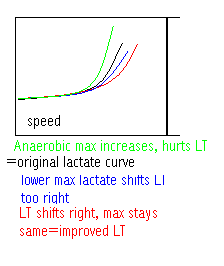| Distance |
Pace per mile |
Speed in Miles per Hour |
Hypothetical Lactate Values |
| 1mile | 6:20 | 9.5 mph | 2.0 |
| 1mile | 6:00 | 10 mph | 2.2 |
| 1mile | 5:43 | 10.5 mph | 2.4 |
| 1mile | 5:28 | 11 mph | 2.7 |
| 1mile | 5:13 | 11.5 mph | 3.9 |
| 1mile | 5:00 | 12 mph | 5.5 |

| Test # |
Lactate Threshold speed (pace
per mile) (aerobic Capacity) |
Max Lactate Value (Anaerobic Capacity) |
| Test 1 |
5:00 |
9.0 mmol |
| Test 2- 6 weeks later |
5:05 |
13.0 mmol |
| Test 3- 6 weeks after test 2 |
4:55 |
13.0mmol |